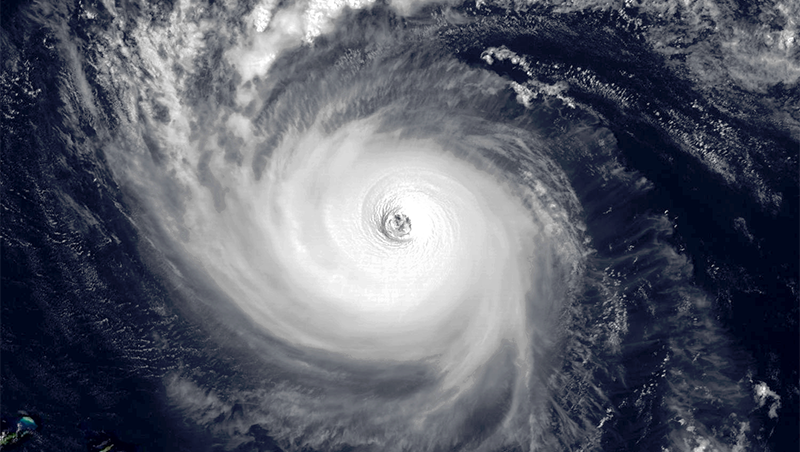Hurricane season starts June 1
Published 4:16 pm Wednesday, June 1, 2022

- Hurricane Isabel, September 12, 2003. NOAA image
|
Getting your Trinity Audio player ready...
|
Today marks the start of the 2022 hurricane season.
Officially running from June 1 through the end of November, the Atlantic Coast hurricane season dates cover the period each year when most tropical cyclones form in the Atlantic basin. The emphasis here is the word “most,” simply because in reality hurricanes can – and have – formed at any time of the year. On average there are about 12 named storms during any given hurricane season with six of them becoming full blown hurricanes.
Prior to the start of any hurricane season, several national meteorological services and scientific agencies publish a forecast for how many named storms, hurricanes and major hurricanes are expected to form during the season and how they will affect a particular country.
Forecasts for the year often begin in December with updates into and through the current season from several national meteorological services, scientific agencies and noted hurricane experts.
This past December 9, Colorado State University issued an extended range forecast for the 2022 hurricane season predicting slightly above-average activity with 13–16 named storms, 6–8 hurricanes, and 2–3 major hurricanes. An April 7, CSU seasonal forecast for the 2022 Atlantic hurricane season predicted above-average activity with 19 named storms, nine hurricanes and four major hurricanes.
Among the most powerful and destructive forces in nature, hurricanes pose a threat to both life and property. The primary hazards from tropical cyclones (which include tropical depressions, tropical storms and hurricanes) are storm surge flooding, inland flooding from heavy rains, destructive winds, tornadoes and high surf and rip currents.
A storm surge is the abnormal rise of water generated by a storm’s winds and are historically the leading cause of hurricane related deaths in the U.S. Dangerous waves produced by a storm’s strong winds pose a significant hazard for coastal residents because these waves can cause deadly rip currents, significant beach erosion and structural damage along the coast even when the storm is several miles offshore.
Flooding from heavy rains, which can persist for several days after a storm has dissipated, ranks as the second leading cause of fatalities from storms making landfall.
Not to be overlooked, hurricane winds can destroy buildings and manufactured homes, rip apart signs, lift off roofing material and convert almost any item left outside into a flying missile.
While locals often know the threat hurricanes can pose, many tend to be a bit apathetic. History has shown, however, that it only takes one storm to change lives and communities.
Evacuations are only called for when the lives and safety of those in the area being evacuated will be a risk. With seasonal increases in population and limited access on and off the barrier islands, major traffic delays will occur during evacuations. Once an evacuation has been called, to ensure your personal safety gather your belongings and leave as soon as possible. In addition to protecting yourself, doing so will save a significant amount of time in traffic while helping emergency officials as they prepare for or respond to the incident.
If you go, know where to go. If ordered to evacuate, know the local hurricane evacuation route(s) to take and have a plan for where you can stay. Because Dare County has only two evacuation routes – Highway 64 West to Tyrrell County and Highway 158 North to Currituck – evacuations can cause major traffic delays. If leaving, make sure to gather belongings and depart in an orderly manner as soon as possible.
Dare County Emergency Management encourages residents and visitors to consider using Highway 64 West, especially those evacuating from Hatteras Island, Nags Head and Roanoke Island. Traffic backups on Highway 158 will occur as traffic from the northern Outer Banks and surrounding counties converge onto Highway 158. Highway 64 West has less congestion and traffic lights; allowing for constant speed. This route intersects Interstate 95 allowing travelers to head north or south to their desired destination. While this route may appear longer on a map or GPS, it is typically faster than evacuating via Highway 158.
There are no American Red Cross approved shelters in Dare County. Inland shelter locations will be broadcast on local media and Current TV as the storm approaches.
• Take blankets or sleeping bags, flashlights, special dietary foods, infant needs and lightweight folding chairs.
• Register every person arriving with you at the shelter.
• Do not take pets, alcoholic beverages or weapons of any kind to shelters.
• Be prepared to offer assistance to shelter workers if necessary and stress to all family members their obligations to keep the shelter clean and sanitary.
Whether you plan to evacuate or stay put, part of the preparation process is to pack an emergency kit with some basic staples like food and water along with any supplies unique to your needs, such as medications or, if appropriate, baby formula.
Water is a key ingredient to any survival plan. Power outages could – and often do – interrupt regular water sources. If possible, store at least three gallons of water per person with enough to last three days. Additional water for flushing toilets could be stored in a bathtub or in buckets. If there is the potential you could be isolated for more than three days, consider adding an extra gallon or two per person per day.
Cash is king. During storm outages, debit and credit cards can become virtually useless. Keep in mind that if banks and ATMs are shut down, you may not be able to access any currency.
Make sure you have enough prescription or over-the-counter medications like pain relievers and antacids.
Non-refrigerated foods can be lifesavers. A three-day supply of canned foods and dry mixes are good for starters, but try to avoid those thirst-inducing foods like salty corn chips. Don’t forget hand-operated can openers and any special dietary needs of those with you. To help cut down on the need for wash water, it’s also a good idea to have some paper goods such as plates and cups as well as some plastic utensils.
A first aid kit, flashlight(s), blankets and battery-operated radio with NOAA weather reception are recommended items.
Extra batteries always prove beneficial during power outages. Portable generators are extremely helpful, but if wired into the household electrical system, make sure it is not back-feeding power into the grid.
Key documents such as identification cards, passport, Social Security cards and insurance policies need waterproof, easy-to-carry containers.
If you are evacuated, once the storm has passed, there is a re-entry process.
Dare County Emergency Management officials urge residents, business owners and non-resident property owners to make sure they have the proper re-entry credentials prior to a hurricane impacting the area. Delay returning until recommended or authorized by local authorities. A staged re-entry process will be used by the Dare County Control Group to facilitate an orderly re-entry.
The Dare County website advises that no one with proper identification will be denied entry.
Proper Identification includes driver’s license with Dare County address, current tax bill or parcel data sheet with matching current government issued ID or a valid re-entry permit.
It is important to note that no re-entry permits are issued within 72 hours of expected landfall of a storm on the Outer Banks. Re-entry passes from previous years will not be accepted.
Re-entry stages following a disaster include:
• Priority One: Essential personnel with a Priority One Critical Personnel Pass issued by the Dare County Control Group.
• Priority Two: Permanent residents and essential personnel for critical businesses with a NC driver’s license with a Dare County address or a tax bill with a matching government issued identification, or Priority Two permit with government issued identification.
• Priority Three: Non-resident property owners and non-resident employees of non-critical businesses with a non-resident re-entry permit or Dare County tax bill with government issued identification matching the name on the tax record or a Priority Three permit with government issued identification.
• Priority Four: General public and visitors; re-entry passes are not needed.
Tax bills can be accessed by going to darenc.com and searching to find your property by name, address or parcel number. Once property is located, click on the tax bill icon and print the record. Be sure the name on the tax bill matches the name on your government issued identification.
For more information regarding re-entry, visit darenc.com/reentry or contact Dare County Emergency Management at 252-475-5655, Monday through Friday from 8:30 a.m. to 5 p.m.
For comprehensive hurricane preparedness information, visit ncready.org.
For updated information regarding the status of all roads and bridges in Dare County and across North Carolina, visit tims.ncdot.gov/tims or call 877-368-4968. For up to date information regarding the status of NC 12, visit facebook.com/NCDOTNC12.
Residents and visitors can contact Dare County Emergency Management by calling 252-475-5655 or visiting darenc.com/departments/emergency-management.
The National Oceanic and Atmospheric Administration recommends anyone in the potential path of severe weather take steps as soon as possible to prepare for potential hurricane conditions.
The list of North Carolina hurricanes includes 413 known tropical or subtropical cyclones that have affected the state. Due to our location, a number of hurricanes have hit the state directly with numerous other hurricanes passing nearby. In fact, North Carolina ranks fourth behind Florida, Texas and Louisiana in the number of cyclones that produced hurricane force winds.
Historically, the largest number of recorded storms affecting North Carolina come in September with the highest storm death toll from an 1857 unnamed storm that resulted in 424 deaths. Overall hurricanes in North Carolina history have been responsible for more than $11 billion in damage and close to 1,000 fatalities.
That’s why developing an evacuation plan, assembling disaster kits and strengthening home and business structures is so important.
For those who want to stay informed, Dare County Emergency Management has the ability to send emergency alerts to residents, visitors and property owners via text, email and over the phone. To sign up, go to smart911.com/smart911/ref/reg.action?pa=darenc.
Important contacts:
Dare County Emergency Management 252-475-5655
Currituck County Emergency Management 252-232-2115
Tyrrell County Emergency Management 252-796-4516
Hyde County Emergency Management 252-542-0806
NC Highway Patrol 800-441-6127
Poison Control 800-222-1222
SPCA (Animal Shelter) 252-475-5620
Attorney General’s Office 877-5-NO-SCAM (price gouging), 919-716-6400
NC Food Protection Division 877-FOOD-644 (food safety), 877-366-3644
Road Conditions:
NC DOT 511 or 877-DOT-4YOU, 877-638-4968
Virginia DOT 800-367-7623
Ferry Service 800-BY-FERRY
Utility Companies:
Dominion/NC Power 866-DOM-HELP, 866-366-4357
Cape Hatteras Electric 866-511-9862, 252-995-5616, 800-454-5616
Tideland Electric (Mainland) 800-637-1079, 252-943-3046
CenturyLink 800-788-3600
Spectrum 833-267-6094
Dare County Water 252-475-5990
CHECK OUT OUR DISASTER PREPAREDNESS GUIDE FOR 2022 HERE.






